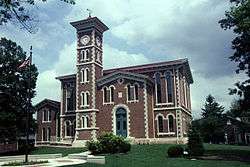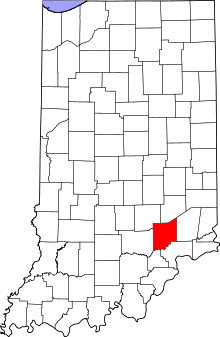Jennings County, Indiana
| Jennings County, Indiana | |
|---|---|
 Jennings County courthouse in Vernon, Indiana | |
 Location in the U.S. state of Indiana | |
 Indiana's location in the U.S. | |
| Founded | 1817 |
| Named for | Jonathan Jennings |
| Seat | Vernon |
| Largest city | North Vernon |
| Area | |
| • Total | 378.34 sq mi (980 km2) |
| • Land | 376.58 sq mi (975 km2) |
| • Water | 1.76 sq mi (5 km2), 0.47% |
| Population | |
| • (2010) | 28,525 |
| • Density | 76/sq mi (29.20/km²) |
| Congressional district | 6th |
| Time zone | Eastern: UTC-5/-4 |
| Footnotes: Indiana county number 40 | |
Jennings County is a county located in the U.S. state of Indiana. As of 2010, the population was 28,525.[1] The county seat is Vernon.[2]
History
Jennings County was formed in 1817. It was named for the first Governor of Indiana and a nine-term congressman, Jonathan Jennings. Jennings was governor when the county was organized.[3]
Geography
According to the 2010 census, the county has a total area of 378.34 square miles (979.9 km2), of which 376.58 square miles (975.3 km2) (or 99.53%) is land and 1.76 square miles (4.6 km2) (or 0.47%) is water.[4] It is a rural county, with majority of the county consisting of personal farms and woodlands. There are only two incorporated towns in this county, Vernon, the county seat, and North Vernon. Both are quite small and underdeveloped by urban standards; many locals prefer to do their shopping in neighboring counties. The county is conveniently located in the center of an imaginary triangle consisting of Indianapolis, IN, Cincinnati,OH, and Louisville, KY and requires only 1 1⁄4 hour drive time to any of these urban centers.
It is also home to the Muscatatuck Urban Training Center, located just outside North Vernon, at which various training exercises and scenarios are conducted for homeland security and other similar purposes.[5]
Cities and towns
Unincorporated towns
- Brewersville
- Butlerville
- Commiskey
- Country Squire Lakes
- Four Corners
- Grayford
- Hayden
- Hilltown
- Lovett
- Nebraska
- Paris
- Paris Crossing
- Queensville
- San Jacinto
- Scipio
- Walnut Ridge
- Zenas
Townships
Adjacent counties
- Decatur County (north)
- Ripley County (east)
- Jefferson County (southeast)
- Scott County (south)
- Jackson County (west)
- Bartholomew County (northwest)
Major highways
Sources: National Atlas,[6] U.S. Census Bureau[7]
National protected areas
Climate and weather
| Vernon, Indiana | ||||||||||||||||||||||||||||||||||||||||||||||||||||||||||||
|---|---|---|---|---|---|---|---|---|---|---|---|---|---|---|---|---|---|---|---|---|---|---|---|---|---|---|---|---|---|---|---|---|---|---|---|---|---|---|---|---|---|---|---|---|---|---|---|---|---|---|---|---|---|---|---|---|---|---|---|---|
| Climate chart (explanation) | ||||||||||||||||||||||||||||||||||||||||||||||||||||||||||||
| ||||||||||||||||||||||||||||||||||||||||||||||||||||||||||||
| ||||||||||||||||||||||||||||||||||||||||||||||||||||||||||||
In recent years, average temperatures in Vernon have ranged from a low of 22 °F (−6 °C) in January to a high of 86 °F (30 °C) in July, although a record low of −24 °F (−31 °C) was recorded in January 1977 and a record high of 105 °F (41 °C) was recorded in July 1954. Average monthly precipitation ranged from 2.71 inches (69 mm) in February to 4.72 inches (120 mm) in May.[8]
Government
The county government is a constitutional body, and is granted specific powers by the Constitution of Indiana, and by the Indiana Code.
County Council: The county council is the legislative branch of the county government and controls all the spending and revenue collection in the county. Representatives are elected from county districts. The council members serve four-year terms. They are responsible for setting salaries, the annual budget, and special spending. The council also has limited authority to impose local taxes, in the form of an income and property tax that is subject to state level approval, excise taxes, and service taxes.[9][10]
Board of Commissioners: The executive body of the county is made of a board of commissioners. The commissioners are elected county-wide, in staggered terms, and each serves a four-year term. One of the commissioners, typically the most senior, serves as president. The commissioners are charged with executing the acts legislated by the council, collecting revenue, and managing the day-to-day functions of the county government.[9][10]
Court: The county maintains a small claims court that can handle some civil cases. The judge on the court is elected to a term of four years and must be a member of the Indiana Bar Association. The judge is assisted by a constable who is also elected to a four-year term. In some cases, court decisions can be appealed to the state level circuit court.[10]
County Officials: The county has several other elected offices, including sheriff, coroner, auditor, treasurer, recorder, surveyor, and circuit court clerk Each of these elected officers serves a term of four years and oversees a different part of county government. Members elected to county government positions are required to declare party affiliations and to be residents of the county.[10]
Jennings County is part of Indiana's 9th congressional district and is represented in Congress by Republican Todd Young.[11] It is also part of Indiana Senate districts 43 and 45[12] and Indiana House of Representatives districts 66 and 69.[13]
Demographics
| Historical population | |||
|---|---|---|---|
| Census | Pop. | %± | |
| 1820 | 2,000 | — | |
| 1830 | 3,974 | 98.7% | |
| 1840 | 8,829 | 122.2% | |
| 1850 | 12,096 | 37.0% | |
| 1860 | 14,749 | 21.9% | |
| 1870 | 16,218 | 10.0% | |
| 1880 | 16,453 | 1.4% | |
| 1890 | 14,608 | −11.2% | |
| 1900 | 15,757 | 7.9% | |
| 1910 | 14,203 | −9.9% | |
| 1920 | 13,280 | −6.5% | |
| 1930 | 11,800 | −11.1% | |
| 1940 | 13,680 | 15.9% | |
| 1950 | 15,250 | 11.5% | |
| 1960 | 17,267 | 13.2% | |
| 1970 | 19,454 | 12.7% | |
| 1980 | 22,854 | 17.5% | |
| 1990 | 23,661 | 3.5% | |
| 2000 | 27,554 | 16.5% | |
| 2010 | 28,525 | 3.5% | |
| Est. 2015 | 27,897 | [14] | −2.2% |
| U.S. Decennial Census[15] 1790-1960[16] 1900-1990[17] 1990-2000[18] 2010-2013[1] | |||
As of the 2010 United States Census, there were 28,525 people, 10,680 households, and 7,733 families residing in the county.[19] The population density was 75.7 inhabitants per square mile (29.2/km2). There were 12,069 housing units at an average density of 32.0 per square mile (12.4/km2).[4] The racial makeup of the county was 96.8% white, 0.8% black or African American, 0.2% Asian, 0.1% American Indian, 1.0% from other races, and 1.2% from two or more races. Those of Hispanic or Latino origin made up 2.0% of the population.[19] In terms of ancestry, 26.2% were German, 16.3% were Irish, 14.7% were American, and 7.2% were English.[20]
Of the 10,680 households, 36.8% had children under the age of 18 living with them, 54.7% were married couples living together, 11.5% had a female householder with no husband present, 27.6% were non-families, and 22.3% of all households were made up of individuals. The average household size was 2.64 and the average family size was 3.06. The median age was 38.4 years.[19]
The median income for a household in the county was $47,697 and the median income for a family was $48,470. Males had a median income of $38,506 versus $27,633 for females. The per capita income for the county was $18,636. About 8.9% of families and 12.3% of the population were below the poverty line, including 16.1% of those under age 18 and 5.4% of those age 65 or over.[21]
Notable residents
- Lincoln Dixon, U.S. Representative from Indiana, 1905–1919
- John "Spider" Miller, 2015 & 2017 Walker Cup team captain
- Jeptha D. New, U.S. Representative from Indiana, 1875–1877, 1879–1881
- Hannah Milhous Nixon, mother of President Richard Nixon
- Pat O'Connor, polesitter for the 1957 Indianapolis 500 and member of the National Sprint Car Hall of Fame
- Jessamyn West, author
- Albert Edward Wiggam, psychologist, lecturer, and author
- Edgar Whitcomb, 43rd Governor of Indiana
- Albert Gumble, ragtime composer [22]
- Moses Gumble, ragtime composer [23]
References
- 1 2 "Jennings County QuickFacts". United States Census Bureau. Retrieved 2011-09-25.
- ↑ "Find a County". National Association of Counties. Retrieved 2011-06-07.
- ↑ De Witt Clinton Goodrich & Charles Richard Tuttle (1875). An Illustrated History of the State of Indiana. Indiana: R. S. Peale & co. p. 563.
- 1 2 "Population, Housing Units, Area, and Density: 2010 - County". United States Census Bureau. Retrieved 2015-07-10.
- ↑ "Muscatatuck Urban Training Center". United States Department of Defense. Retrieved 2007-10-05.
- ↑ National Atlas
- ↑ U.S. Census Bureau TIGER shape files
- 1 2 "Monthly Averages for Vernon, Indiana". The Weather Channel. Retrieved 2011-01-27.
- 1 2 Indiana Code. "Title 36, Article 2, Section 3". IN.gov. Retrieved 2008-09-16.
- 1 2 3 4 Indiana Code. "Title 2, Article 10, Section 2" (PDF). IN.gov. Retrieved 2008-09-16.
- ↑ "Conressman Baron Hill". House.Gov. Retrieved 2008-09-12.
- ↑ "Indiana Senate Districts". State of Indiana. Retrieved 2011-07-14.
- ↑ "Indiana House Districts". State of Indiana. Retrieved 2011-07-14.
- ↑ "County Totals Dataset: Population, Population Change and Estimated Components of Population Change: April 1, 2010 to July 1, 2015". Retrieved July 2, 2016.
- ↑ "U.S. Decennial Census". United States Census Bureau. Retrieved July 10, 2014.
- ↑ "Historical Census Browser". University of Virginia Library. Retrieved July 10, 2014.
- ↑ "Population of Counties by Decennial Census: 1900 to 1990". United States Census Bureau. Retrieved July 10, 2014.
- ↑ "Census 2000 PHC-T-4. Ranking Tables for Counties: 1990 and 2000" (PDF). United States Census Bureau. Retrieved July 10, 2014.
- 1 2 3 "DP-1 Profile of General Population and Housing Characteristics: 2010 Demographic Profile Data". United States Census Bureau. Retrieved 2015-07-10.
- ↑ "DP02 SELECTED SOCIAL CHARACTERISTICS IN THE UNITED STATES – 2006-2010 American Community Survey 5-Year Estimates". United States Census Bureau. Retrieved 2015-07-10.
- ↑ "DP03 SELECTED ECONOMIC CHARACTERISTICS – 2006-2010 American Community Survey 5-Year Estimates". United States Census Bureau. Retrieved 2015-07-10.
- ↑ http://www.ragpiano.com/comps/agumble.shtml
- ↑ http://www.ragpiano.com/comps/mgumble.shtml
See also
- National Register of Historic Places listings in Jennings County, Indiana
- USS Jennings County (LST-846)
 |
Bartholomew County | Decatur County |  | |
| Jackson County | |
Ripley County | ||
| ||||
| | ||||
| Scott County | Jefferson County |
Coordinates: 39°00′N 85°38′W / 39.00°N 85.63°W
